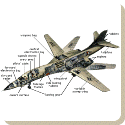 B-1 Bomber — The supersonic, variable-wing B-1 bomber is able to carry more armament (up to 52,160 kg/115,000 lb) than any other combat aircraft. It was designed to replace the B-52 as the primary nuclear bomber of the United States. Its variable wing (forward for subsonic flight; swept back for supersonic flight) gives it a near-sonic, low-altitude penetration capability, as well as a high-altitude, supersonic capability. All the B-1’s subsystems are duplicated. If a subsystem has one failure, the mission can be completed (fail-operative); if a second failure occurs in the same system, the mission can still be safely aborted and the bomber returned to base (fail-safe). The fail-operative, fail-safe requirement accounts for the extremely high density of equipment in the aircraft.
B-1 Bomber — The supersonic, variable-wing B-1 bomber is able to carry more armament (up to 52,160 kg/115,000 lb) than any other combat aircraft. It was designed to replace the B-52 as the primary nuclear bomber of the United States. Its variable wing (forward for subsonic flight; swept back for supersonic flight) gives it a near-sonic, low-altitude penetration capability, as well as a high-altitude, supersonic capability. All the B-1’s subsystems are duplicated. If a subsystem has one failure, the mission can be completed (fail-operative); if a second failure occurs in the same system, the mission can still be safely aborted and the bomber returned to base (fail-safe). The fail-operative, fail-safe requirement accounts for the extremely high density of equipment in the aircraft.
The B-1 Lancer is an American supersonic strategic bomber with variable geometry wings. Its origins began in the 1960s as a supersonic bomber with sufficient range and payload to replace the original B-52 Stratofortress. The B-1B production version has been in service with the United States Air Force (USAF) since 1986. The Lancer serves with the B-52 and the B-2 Spirit as the supersonic-capable component of the United States’s long-range bomber force. As with several official popular names, the Lancer is commonly called the Bone within the US Air Force. With the retirement of the EF-111 Raven in 1998 and the F-14 Tomcat in 2006, the B-1B is the last swing wing aircraft remaining in the US inventory.
History
The B-1 was conceived as the Advanced Manned Strategic Aircraft (AMSA) program circa 1965. AMSA was the last in a series of programs through the 1960s that looked at replacing the B-52 Stratofortress with a multi-role supersonic aircraft capable of long-range bombing and missile launching with nuclear weapons.
Background
In 1955, the USAF released system requirements for a heavy bomber with the B-52’s range and payload and the B-58’s supersonic speed to replace these bombers by 1965. The initial requirements called for a Mach 0.9 cruise speed with a Mach 2+ dash capability. This work would eventually lead to the B-70 Valkyrie, a much more capable design. The Valkyrie was a large six-engine bomber designed to fly at very high altitudes at Mach 3 to avoid defending interceptors, the only effective anti-bomber weapon at that point in time.
The introduction of effective anti-aircraft missiles rendered this mode of operation dangerous. Radars are line-of-sight, so the high flying Valkyrie would be visible even at very long ranges. For instance, the SA-2 Guideline’s primary search radar had a nominal range of 170 miles against a high flying target. This would give the operators about five minutes warning at the Valkyrie’s cruising speed, more than enough to launch an attack. Combined with increased reliance on ICBMs instead of bombers in the strategic role, the Valkyrie program was eventually canceled by President Kennedy largely for these reasons, and the aircraft were used for test vehicles.
In response to the new missile threat, SAC planners instead switched B-52 bombers to low-altitude penetration. By carefully selecting the line of approach to a target and routing around known anti-aircraft sites, the same line-of-sight issue worked in the bomber’s advantage by hiding it from view below the landscape. The targets themselves often had defenses located nearby to prevent this sort of approach all the way in, but stand-off weapons like cruise missiles and AGM-69 SRAM allowed attack from outside the defensive missile’s range. The aircraft could simply blast their way through a path of defenses and attack the target, remaining in relative safety. Low-altitude flight also made the bombers very difficult to detect from aircraft at higher altitudes, including interceptors, as radar systems of that generation could not “look down” due to the clutter of the ground reflections.
Although never intended for this role, the B-52’s flexibility allowed it to outlast its intended successor as the nature of the air war changed. Operations at low levels would limit the B-70’s speed to the subsonic, while dramatically decreasing range due to much higher fuel requirements. The result would be an aircraft with similar speed but much less range than the B-52 it would have replaced. This was not a purely theoretical issue, this exact problem had actually occurred with the B-58, another high-speed aircraft that was forced into the low-level role to avoid missile defenses. The design had “spent” a lot in gaining medium-range Mach 2 performance, but at low altitudes it had strictly subsonic performance and such dramatically reduced range that it limited the selection of targets that could be assigned to it. The “outdated” B-52 outperformed it, as it would have the B-70.
Additionally, no other aircraft had anything like the B-52’s bombload. During the Vietnam war, B-52s with “big belly” modifications delivered massive loads of high explosive bombs. They proved effective against both industrial targets as well as troop concentrations. With improved coordination with ground spotters, three-plane formations at high altitude had proven to be superb ground-attack weapons. The same would not be true of the Valkyrie, which would have had limited uses in the conventional bombing role and featured a much smaller bombload at 25,000 pounds.
That was not to say the B-52 was a perfect solution to these problems. Higher speed would aid even a low-level approach in the strategic role, something the F-111 was taking advantage of. In the high-load tactical role the aircraft was limited to a small number of airfields due to its very long takeoff roll. By the early 1960s the state of the art in engine and airframe design had improved considerably, an aircraft designed to the B-52’s roles could meet both of these additional requirements. Although the B-52 had proven to be surprisingly adaptable in both the strategic and tactical roles, during the early 1960s a number of studies followed these technical developments in order design a worthy B-52 replacement.
 Kids Portal For Parents India Kids Network
Kids Portal For Parents India Kids Network
